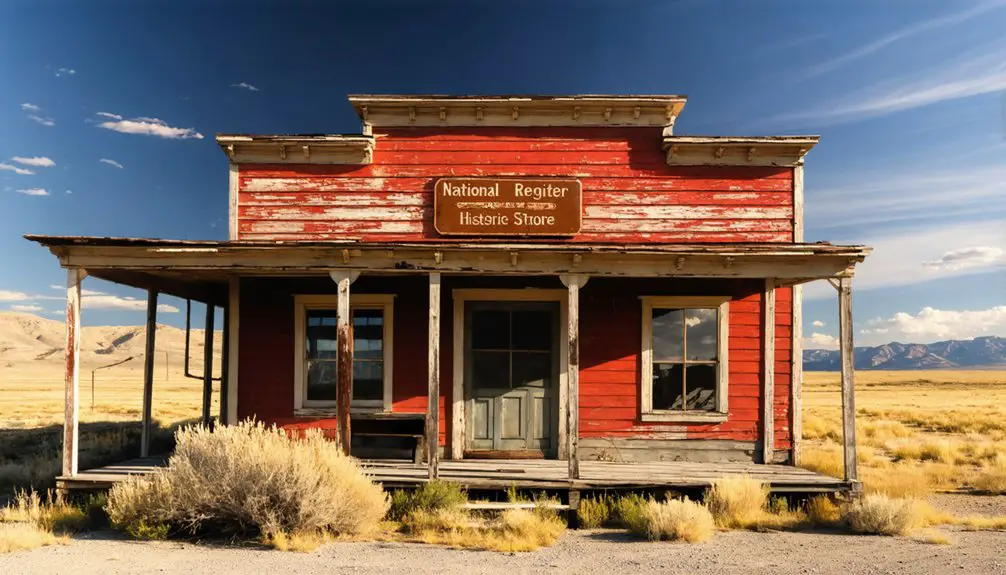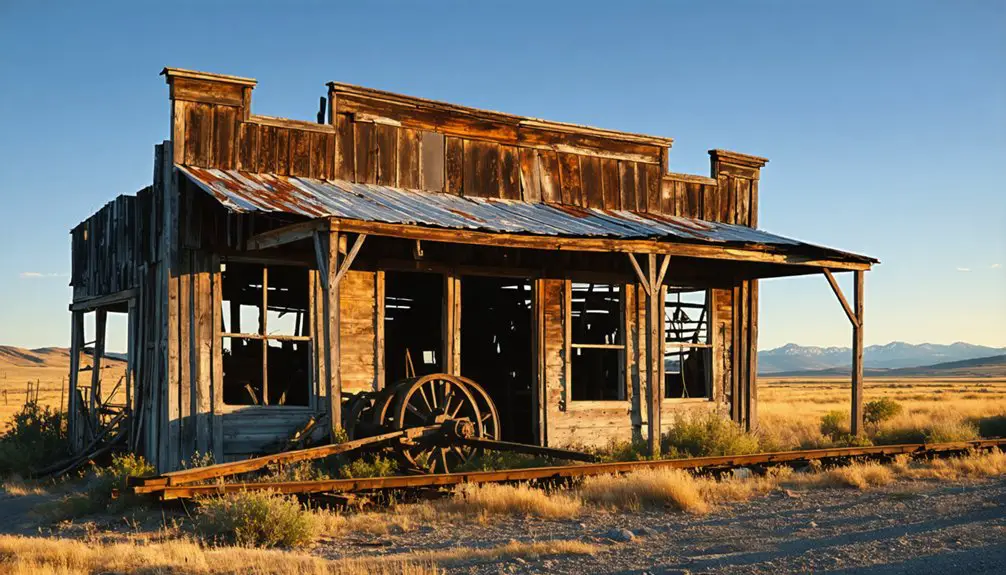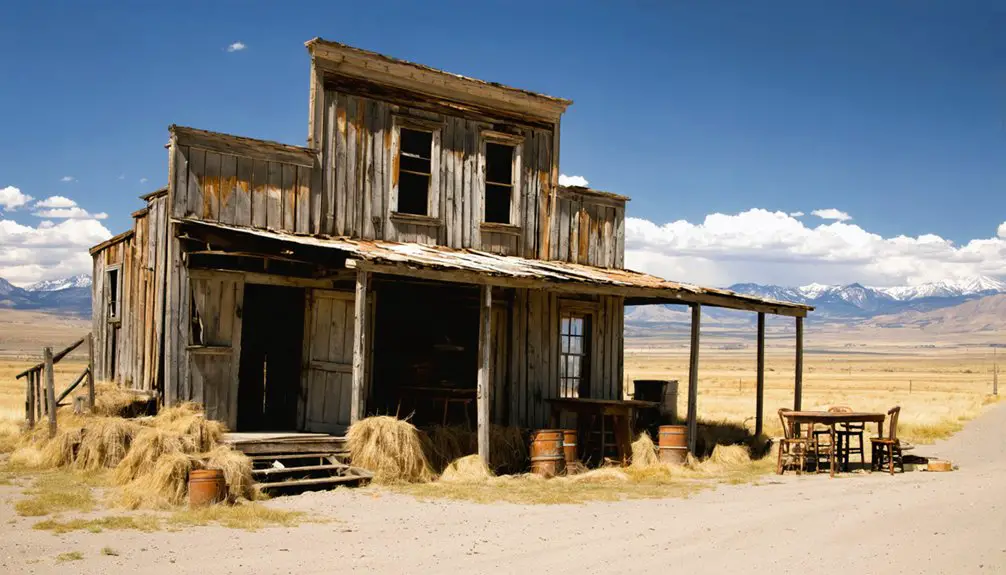You’ll find Lonetree in Chouteau County, Montana, a ghost town established in 1885 as a gold and silver mining settlement. Originally named Steele, it thrived until 1915 with a peak population of 300 residents. At 3,123 feet elevation, the site features remnants of timber and stone structures from its mining heyday. Listed on the National Register of Historic Places since 1980, this preserved settlement holds countless stories of Montana’s mining heritage beneath its weathered facades.
Key Takeaways
- Lonetree, established in 1885 as a gold and silver mining town, became a ghost town after its post office closed in 1915.
- The town reached its peak population of 300 during 1885-1892, driven by successful mining operations producing 2,000 tons annually.
- Located in Chouteau County, Montana at 3,123 feet elevation, Lonetree features historic timber and stone structures from frontier mining days.
- The site was listed on the National Register of Historic Places in 1980, preserving its significance in Montana’s mining heritage.
- Mining operations faced challenges from groundwater flooding and high operational costs, ultimately leading to the town’s abandonment.
The Rise and Fall of a Mining Settlement
While Montana’s mining boom era spawned numerous settlements, Lonetree emerged in 1885 as a promising gold and silver mining community that would experience both dramatic success and eventual abandonment.
Like the historic Drumlummon mine claim of 1876, Lonetree’s earliest operations helped establish mining’s importance in Montana Territory.
You’ll find the community dynamics were initially shaped by individual prospectors and small companies establishing hard rock mining operations, complete with tunnels, shafts, and stamp mills.
To prevent confusion with other similarly named locations, the town was often referred to as Lone Tree Montana in historical documents.
Under competent management, the mines flourished, processing hundreds of thousands of tons of ore and generating substantial profits.
However, mining conflicts and corporate infighting began to plague operations. Fierce competition over vein ownership and ongoing stockholder disputes disrupted the town’s stability.
Geographic Location and Natural Setting
Located in Chouteau County’s north-central Montana, Lonetree’s geographic position reflects the strategic placement of many mining settlements from the late 1800s. Like the ghost town of Garnet, Lonetree offered spectacular mountain vistas.
You’ll find it at 47°32′30″N latitude and 110°17′03″W longitude, with an elevation of 3,123 feet above sea level. The town sits where the Great Plains meet the mountain convergence zone, offering views of the Castle Mountains. Modern GPS enthusiasts can locate the site using UTM coordinates 12T 553897.66091899 5265238.2339194.
The area’s geographic features include natural grasslands and sparse tree cover, typical of Montana’s varied terrain. You’ll experience four distinct seasons with climate conditions ranging from cold winters to warm summers.
The semi-arid environment receives moderate precipitation, mostly as snow. While the Milwaukee Road once served the town, today you’ll need to navigate more remote access routes to reach this historic site, which has been listed in the National Register since 1980.
Historical Timeline and Key Events
Three significant phases mark Lonetree’s historical timeline, beginning with its 1885 establishment under the name Steele.
The first phase saw the opening of a post office in 1888, signifying the community’s growing importance. You’ll find this postal history reflects the town’s early development and connection to the wider region. Similar to Comet City’s post office establishment in 1877 by Russell, postal services were crucial for connecting mining communities.
The second phase began in 1914 when the town’s name changed to Lonetree, representing a shift in community identity.
However, this transformation proved short-lived, as the third phase – the town’s decline – followed swiftly. The post office closed by March 1915, effectively ending Lonetree’s active period.
The town’s final notable event came in 1980 with its addition to the National Register of Historic Places.
Life in Early Lonetree
As settlers established themselves in early Lonetree, they formed a tight-knit community centered around mining and agricultural pursuits at an elevation of 3,123 feet.
You’d find them living in simple timber and stone dwellings, built to withstand Montana’s harsh climate. Their homes, typically one or two-room cabins, relied on wood stoves for heating and cooking.
Daily life revolved around agricultural practices, including small-scale farming and livestock management, supplemented by hunting and trading. Early residents often married Native American women who provided crucial knowledge about surviving the harsh local environment.
Community gatherings often took place around the post office, which operated from 1888 to 1915, while seasonal festivals and church meetings strengthened social bonds.
You’d see a mix of cultural influences, from Native American traditions to fur trader heritage, shaping the community’s customs.
Transportation remained basic, with residents relying on horses and wagons for mobility.
Mining Operations and Economic Impact
You’ll find that Lonetree’s mining operations relied heavily on traditional hard rock mining methods, extracting copper and silver ore through a network of shafts that produced nearly 2,000 tons annually during peak years.
The town’s economic fortunes soared from 1885-1892, with mining payrolls fueling local businesses and infrastructure development while supporting a population of 300 residents.
Mining Methods and Equipment
Mining operations at Lonetree centered on hard-rock underground methods, with miners tunneling approximately 500 feet into gold-bearing veins under Thomas Cruse’s direction.
The mining technology employed stamp mills with five heavy steel stamps that crushed gold-silver ore for extraction. You’ll find that timber supports were essential for tunnel stability in the fractured Rocky Mountain bedrock.
Underground ore extraction faced persistent challenges from groundwater intrusion, requiring pumps for dewatering operations.
The processing facilities included gravity separation circuits, and later developments suggested the use of autoclaves for treating refractory ores. The site’s processing plant and autoclave at Lone Tree remained as substantial infrastructure long after initial operations ceased.
Workers transported ore to surface mills using manual or horse-drawn methods in the late 19th century.
Complex mineralogy at depths below 210 meters demanded sophisticated processing techniques for profitable gold recovery.
The mine was located at 5,400 feet elevation, making operations particularly challenging in extreme weather conditions.
Economic Rise and Decline
While initial exploration at Lonetree began in the late 19th century, the mine’s major economic development commenced in 1990 with a $52.9 million capital investment that launched full-scale operations by April 1991.
The economic trends show early success, with cash operating costs of $103.45 per ounce of gold and extensive exploration evidenced by over 400 drill holes completed by 1992. The mine’s forecast production of 103,000 ounces gold demonstrated its significant economic potential. The facility included a whole ore autoclave capable of processing various types of gold-bearing mineralization.
You’ll find the mine’s history marked by significant challenges. The historic Montana Mining Company extracted 500,000 tons of ore worth $9.2 million before facing decline.
Management issues, stockholder disputes, and large groundwater inflows complicated operations. A high strip ratio of 5-6 increased waste removal costs, while complex infrastructure needs and disappointing exploration results ultimately led to the mine’s transformation into today’s ghost town.
Architecture and Infrastructure
Frontier pragmatism defined the architectural character of Lonetree, Montana, with its primarily wooden structures built from locally sourced timber.
You’ll find the town’s simple wooden architecture reflected the practical needs of its mining community, with log cabins and basic frame houses arranged along a central dirt road at 3,123 feet elevation.
The town’s infrastructure remained minimal throughout its existence.
You won’t find evidence of paved roads, electricity, or running water. Instead, residents relied on wells and springs for water, while the post office, operating from 1888 to 1915, served as the primary communication hub.
Today, you’ll see mostly scattered ruins and foundation outlines where buildings once stood, as the temporary nature of the wooden architecture has succumbed to time and weather.
National Register Recognition

Lonetree’s addition to the National Register of Historic Places in 1980 marked a significant step in preserving this Montana ghost town‘s historical legacy.
You’ll find the entire community, rather than individual structures, protected under this designation, which acknowledges Lonetree’s role in Montana’s settlement patterns from its 1885 founding.
The listing process documented the site’s coordinates at 47°32′30″N 110°17′03″W and preserved its alternate names of Lone Tree and Steele, ensuring future generations can study this important piece of frontier heritage.
Historical Preservation Significance
Through its designation on the National Register of Historic Places in 1980, Lonetree stands as a protected monument to Montana’s late 19th-century pioneer settlements.
This recognition safeguards the town’s cultural heritage and strengthens community identity by preserving a tangible link to frontier life.
The designation provides several key preservation benefits:
- Federal protection from government projects that could harm the site’s historic integrity
- Enhanced eligibility for preservation grants and funding opportunities
- Formal documentation requirements that help maintain historical records
- Support for local advocacy efforts to protect remaining structures
You’ll find that Lonetree’s listing plays an essential role in Montana’s broader preservation strategy, ensuring that future generations can experience and understand the challenges and triumphs of pioneer life in the American West.
Listing Process Details
Achieving National Register recognition for Lonetree required a meticulous five-stage process that began with detailed nomination preparation and culminated in final approval from the National Park Service.
You’ll need to complete Form NPS 10-900, documenting the ghost town’s physical features and historical significance to meet nomination criteria.
The Montana State Historic Preservation Office then reviews your submission and forwards it to the state advisory council.
You’re required to notify property owners and the public, allowing them to voice support or objections during the review process.
The state commission evaluates Lonetree’s eligibility based on age, significance, and integrity before recommending it to the National Park Service.
The Keeper of the National Register makes the final determination within 45 business days.
Preservation Efforts and Current State
Several major preservation initiatives safeguard Montana’s ghost town heritage, with the Montana Ghost Town Preservation Society leading efforts since its establishment in 1969.
Despite ongoing funding challenges, you’ll find strong community involvement through events, tours, and collaborative projects that help maintain these historic sites.
Key preservation activities include:
- State-funded grants totaling nearly $6 million for historic preservation across 21 communities
- Annual conventions and educational programs promoting ghost town conservation
- Structural stabilization projects to protect original buildings from weather damage
- Tourism-driven preservation through events like “Bannack Days” featuring historical reenactments
Today, you can explore numerous standing structures in Montana’s ghost towns, though they face continuous challenges from natural weathering.
Professional oversight and community support remain essential for protecting these irreplaceable historical treasures.
Lonetree’s Legacy in Montana’s Mining Heritage

While preservation efforts maintain Montana’s ghost towns today, Lonetree stands as a compelling tribute to the state’s rich mining heritage.
You’ll find its story woven into Montana’s mining boom of the 1880s, when the town emerged during an era of ambitious gold and silver exploration.
Beyond the typical mining myths of quick riches, Lonetree’s legacy includes its unique transformation into one of Montana’s intriguing “health mines” during the mid-20th century.
Lonetree legends grew as the mine shifted from mineral extraction to wellness tourism, joining other sites like Earth Angel and Sunshine in offering supposed therapeutic benefits.
The town’s 1980 inclusion in the National Register of Historic Places cements its significance in Montana’s mining narrative, preserving a distinctive chapter of economic and cultural evolution.
Frequently Asked Questions
Are There Any Documented Paranormal Activities or Ghost Sightings in Lonetree?
You’ll find documented ghost encounters including phantom piano music at Kelley’s Saloon, shadowy figures in windows, self-operating wood stoves, and feelings of being followed, though local legends remain relatively modest.
What Wildlife Species Currently Inhabit the Abandoned Lonetree Town Site?
You’ll find rich species diversity through wildlife observation, including Canada lynx, black bears, mountain lions, elk, mule deer, moose, various grouse species, and raptors in this remote, forested habitat.
How Safe Is It for Visitors to Explore Lonetree Today?
You’ll need significant safety precautions due to unstable structures, remote location, and limited emergency services. Without guided visitor experiences, exploring independently requires thorough preparation and assumes considerable personal risk.
What Specific Minerals or Metals Were Primarily Mined in Lonetree?
Like veins running through nature’s treasure chest, you’ll find that gold was the primary metal mined here, with silver mining playing a secondary role. Copper extraction occurred but wasn’t a major focus.
Are Metal Detecting and Artifact Collecting Allowed at Lonetree?
You can’t legally metal detect or collect artifacts at Lonetree without permits due to strict metal detecting regulations. Federal laws protect historical sites, and artifact collecting ethics require leaving historical items undisturbed.
References
- https://en.wikipedia.org/wiki/Lonetree
- https://www.youtube.com/watch?v=Q8pKSHGds74
- https://www.garnetghosttown.org/history.php
- https://avrextravel.com/montana-ghost-towns/
- https://publizr.com/ghosttownsandhistoryofmontana?lang=nl
- https://archiveswest.orbiscascade.org/ark:/80444/xv28731
- https://mhs.mt.gov/education/textbook/chapter6/Chapter6.pdf
- https://mhs.mt.gov/education/Elementary/MAHOOHTimeline.pdf
- https://en.wikipedia.org/wiki/Gold_mining
- https://latitude.to/articles-by-country/us/united-states/300067/lonetree-montana



